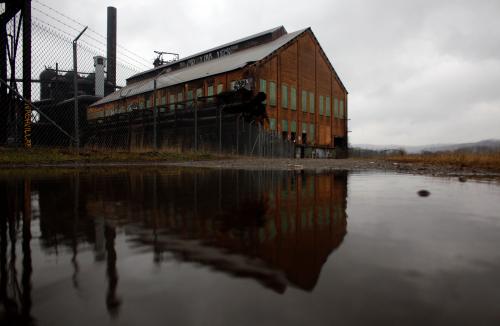Following a string of water main bursts in Atlanta, the country is once again grappling with an age-old conundrum: how to stay ahead of an increasingly intractable list of water infrastructure challenges. Corroded pipes—some nearly a century old—failed near downtown and Midtown Atlanta, leading to shutoffs, boil-water advisories, and growing frustrations for thousands of households and businesses (the final tally is still unclear). Repair crews raced to fix the bursts and local leaders pledged financial relief for those affected, but ongoing concerns remain over the full extent of the water system’s needs.
Atlanta’s water needs are locally problematic, but they are also nationally emblematic of a broader water infrastructure challenge: America is failing to invest enough in its water systems.
From Flint, Mich., to Jackson, Miss., to a seemingly unending number of urban and rural communities, the country’s water infrastructure is aging and in need of repair. Contaminated drinking water, including lead pollution, is often the most glaring sign of an often-invisible challenge. But leaking pipes, combined sewer overflows, and other chronic issues persist too. An increasingly destructive climate, including more frequent floods and droughts, is not helping matters either. The ripple effects of these failures are also extensive across different systems, leading to network failures across neighborhoods and entire regions.
More than $600 billion in investment is estimated to be needed over the next 20 years to keep up with all the necessary improvements, according to the latest EPA national water assessments. Even with more federal funding from the Infrastructure Investment and Jobs Act (IIJA), these estimates continue to escalate.
Water main bursts like those in Atlanta are the quintessential example of our investment backlog. An estimated 260,000 pipe failures happen each year, or about 11.1 breaks for every 100 miles of pipes, based on a survey conducted by Utah State researchers. Many of these pipes are older (53 years on average) and made of more susceptible materials such as cast iron. But more striking is that an estimated 20% of pipes in this survey are beyond their useful life and will require $452 billion to replace.
While these various water infrastructure needs and costs are concerning in themselves, the bigger issue is the lack of financial capacity to address them. Local water utilities are the primary owners and operators of this infrastructure, responsible for upwards of 90% of all public spending each year on the country’s water needs. Yet, with more than 50,000 utilities in the U.S., they are often highly localized and fragmented in their operations and service areas, as well as limited in their ability to generate predictable and durable revenue from ratepayers. That’s especially the case in cities like Flint and Jackson that have endured population loss and economic disinvestment over many decades. The tension between balancing water investment and affordability is ever-present.
The financial pressure is immense on local utilities—and other state agencies—who are constantly trying to cobble together enough resources to stay ahead of these needs. Beyond increasing rates, utilities are implementing new fees (e.g. stormwater fees) to keep up with the pace of repairs and other regulatory pressures. They are appealing to voters and passing ballot referenda; Atlanta, in fact, recently approved a one-cent sales tax to cover needed water upgrades. Utilities are also investing in more cost-effective designs, technologies, and other upgrades to provide more reliable service; Atlanta has also invested in widespread pipe improvements and more resilient green infrastructure installations.
But even these steps are not enough, as Atlanta’s recent experience demonstrates. So where does the country go from here?
The first step is to establish increased, sustained federal water funding. While the IIJA pumped about $57 billion into a host of different water infrastructure improvements, this figure still pales in comparison to the price tags noted earlier. Even when including additional funding for watershed and resilience improvements from the Inflation Reduction Act (IRA), there is still an outstanding needs gap. Federal investment, ideally tuned to need and ability to pay, can ensure all communities gain the resources they need. Recent conversations in Washington have generally supported more investment, including reauthorization of funding for flood control and other waterway projects. But the reality is that federal funding lags behind the full scale of water needs nationally, and utilities are scrambling for predictable resources.
The second step is to support continued local and state experimentation. While many utilities are struggling to simply keep up with existing repairs, that should not be an excuse for failing to test more proactive and collaborative solutions. Considering alternative revenue sources, breaking down governance siloes, and creating new asset management strategies are among these possible solutions. Admittedly, larger urban water systems tend to have greater capital budgets, existing financial resources, and staffing levels to accelerate new types of projects and other repairs. Seattle, for instance, has established more comprehensive and community-led plans around different upgrades, as have utilities in Milwaukee, Washington, and other cities. But utilities in more resource-constrained cities like Camden, N.J., and Buffalo, N.Y., are also launching innovative plans and partnerships to accelerate improvements.
Atlanta’s water dilemma is not an isolated phenomenon. Expect more water disruptions in the months and years to come. At this point, it’s not a question of if, but when in many communities. As these challenges and their associated price tags mount, though, they will serve as continual reminders of the need for more sustained funding and proactive innovation.
The Brookings Institution is committed to quality, independence, and impact.
We are supported by a diverse array of funders. In line with our values and policies, each Brookings publication represents the sole views of its author(s).




Commentary
Atlanta’s water burst is the latest reminder of America’s mounting water bill
June 6, 2024